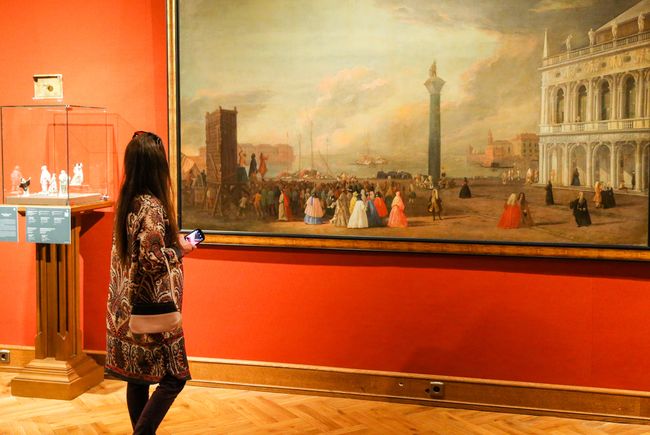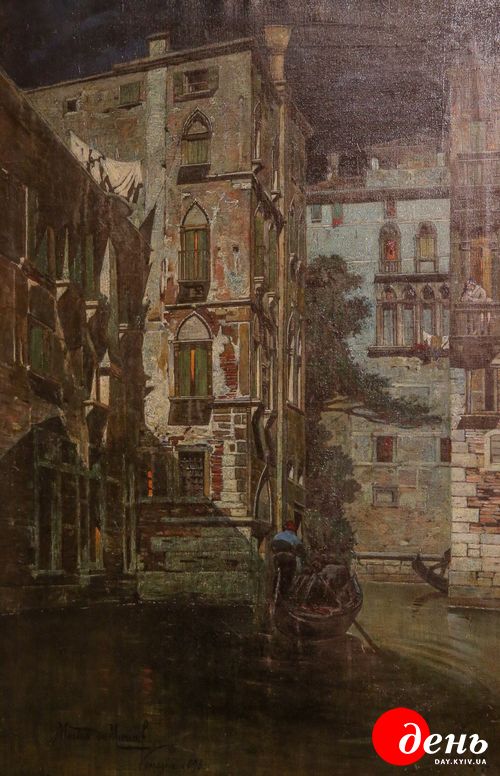Venice and its myths
The Khanenko Museum displays the legendary city’s 16th-19th-century art
The Most Serene Republic of Venice existed in what is now north-eastern Italy for about 1,000 years from 751 until 1797. Its capital, Venice, is associated with endless legends and has long been a destination of the pilgrimage of artists, rich people, and just dreamers of any profession and means.
Many have heard of the Carnival of Venice, the Doge’s Palace, the Murano glass, and the Burano lace-making. But do you know that female artists worked in Venice several centuries ago? We learned this and much more about Venice and its masters at the exhibit “Most Serene Venice – Venezia la Serenissima” at the National Bohdan and Varvara Khanenko Museum of Arts. It is a joint project of the museum and the Lviv National Borys Voznytsky Art Gallery as part of the European Dimension program.
TITIAN’S FOLLOWER
The project was first presented in Lviv this year, but the Kyiv exhibit turned out to be entirely different – in particular, because some artworks just cannot be transported. Among them are miniatures by the famous artist Rosalba Carriera and an absolutely astonishing 17th-18th-century cupboard. Many items are being displayed for the first time.

MARIUS PICTOR, “NIGHT IN VENICE”
In the first hall, you can see Venetian portraits, historical paintings, and landscapes, as well as items associate with commedia dell’arte. “Portrait of a Young Lady,” painted in 1621 by Chiara Varotari, is interesting from both artistic and historical viewpoints. It shows in detail the gorgeous attire of a girl from a wealthy family, perhaps an aristocrat.
“In addition to painting and being the follower of Titian, Chiara Varotari wrote a treatise in defense of the female gender [“Apology for the Female Sex.” – Author], received with pleasure a lot of women in her studio, and educated a whole generation of Venetian female artists,” says Olena Zhyvkova, exhibit curator, deputy director general of the Khanenko Museum for research.
IDENTIFYING A PROCURATOR
Another portrait, from the Lviv Art Gallery, is an early copy of Paolo Veronese’s “Boy with a Greyhound” kept at New York’s Metropolitan Museum of Art. The picture, dated 1560, shows Nestore Martinengo, an aristocrat by birth. What makes the item particularly valuable is the so-called “Sansovino frame.” This type of framing is named after the architect and sculptor Jacopo Sansovino. The characteristic features of this ornamentation are a polychromic coating, numerous volutes, and mascarons. According to Ihor-Andrii Zhuk, exhibit co-curator, in charge of the 14th-18th-century European art collection at the Lviv Art Gallery, this kind of frames gained popularity in 1560-70 not only in Venice, but also in Florence and Bologna.
The man in a purple ermine-trimmed velvet cloak from a 17th-century portrait undoubtedly belonged to the wealthy class. What gives us a clue is a broad strip of stamped velvet, the so-called stole, which identifies a procurator, one of the highest ranks in the Venetian Republic. Yet it is not known who is depicted on the portrait from the Lviv Art Gallery. The man holds a sheet on which one can read the name of Grimani. Zhuk says it was one of the most influential families in Venice. Anyway, the note’s text needs to be further researched.

A CHAIR. VENICE, ITALY, 18th CENTURY
IDEAL SILK
In the second hall, one can see the stole that adorned the procurator’s clothes, for a part of the exposition is about Venetian weaving. “Venetian weavers were the first in Europe to make silk,” Zhyvkova says. “Venice was a hub of European trade routes. The most gorgeous textiles from the Orient began to come first to Venice and then to other countries of Europe. Therefore, having these specimens, local weavers brought in silkworm cocoons and began making brilliant silks. The Venetian silk with large-size repeat ornament is very nice in color. The color is very fast because specific dyes were used.” Incidentally, guilds saw to it that masters took a certain amount of the dye and made a high-quality textile – this is the way they maintained the prestige of the Venetian brand.
BIBLICAL KING IN VENETIAN ATTIRE
Venetian textiles are meticulously depicted in the 18th-centuty picture “King David and the Prophet Gad” by Francesco Fontebasso. Zhyvkova says that when Venetian artists painted on biblical themes, they relied on the things they knew. This is why King David is dressed like a patrician of the Most Serene Venice.
The picture’s theme also closely echoes the life of the republic. The plot is from the Old Testament: King David decided to conduct a census contrary to God’s will, and the wrathful Almighty offered him, via the prophet Gad, to choose one of the three punishments: war, famine, or pestilence. They are all allegorically depicted as a sword, a dry tree branch, and a skull in the hands of an angel in the top left corner. David chose pestilence which left 70,000 people dead in a day.

ROYAL CHINAWARE
Venice knew very well what pestilence was because there had been more than one outbreaks of plague there since the 14th century. Besides, the biblical story says the king is to blame for the pestilence, and, according to Zhyvkova, Venetian rulers were also sometimes blamed for plague epidemics.
A “TOURIST” PORTRAIT
Among the most staggering artworks are ivory miniatures by the famous Venetian female artist Rosalba Carriera, which date back to the 18th century.
In general, this kind of portrait is Rosalba’s invention which Europe picked up later. “Like all sound-minded artists, Rosalba Carriera wanted to earn. Venice was a tourist city in the 18th century. Artists dreamed of selling their works. If you commission an artist to paint your portrait in carnival apparel, you will have to pose for weeks, and then you must carry the picture somewhere, perhaps across all of Italy… Rosalba invented the following pattern: she makes small workpieces in her studio, thus working out certain techniques which she then applies at a higher level, and adds a face later. It is like in our tourist photographs, when you need to insert a face into some framing.”
One of the miniatures depicts Caterina Sagredo Barbarigo, also a legendary figure. “Every Venetian wanted to meet this lady,” Zhyvkova maintains. “Caterina came from a very rich and old family, but she was mostly known for sticking to a masculine lifestyle. She set up a literary salon, had some palaces rebuilt, invited Tiepolo to paint them, was an art patron, played at and ran Ridotto [Europe’s first casino. – Author]. She was doing all she wanted to, and this was possible in Venice only.”
A MYTH ABOUT LAWS AND PEACE
Why was it so? The answer is in Rosalba’s other miniature, an allegory of Venice, which used to be called “A Couple of Lovers.” “The Venetian state was constantly creating myths about itself. From the 16th century onwards, there was the following myth about Venice: this state is based on the absolute rule of law and is always trying to establish ties with other countries in a peaceful way. Law and peace are the central foundations of the Venetian Republic,” Zhyvkova stresses. “From the 16th century on, the most noted Venetian artists depicted these, I would say, significant and allegorical female figures – it is a very lasting image.”

A BOWL. MURANO, VENICE, ITALY
In the miniature, a blonde woman hugs another one and holds a palm that symbolizes peace, while a dark-haired woman, who put her hand on the fasces – bundles of lictors’ rods with an ax, – impersonates justice and the law.
Of course, everything was not so idyllic in reality. “If you whispered into your friend’s ear that Venice was bad, you might be thrown to prison. The state was very strong. But individuals also had the right to express themselves, provided they did not transgress the law or malign Venice,” Zhyvkova continues. “Another myth is that Venice was a very peaceful state. In reality, it always took part in some wars.”
A HEAVENLY NOOK FOR THE INTELLECTUAL
Olena Zhyvkova calls the 17th-18th-century bureau cabinet the exhibit’s code. She adds that no other museums of the world have analogs to it. This is the first time the item is being displayed.
The cabinet stands with its doors open. The mirror visually doubles the wall paintings. The cabinet doors look rather modest on the outside, but when they are open, you seem to be standing by the entrance to the villa in the style of the famous architect Andrea Palladio because, on the inside, the bureau cabinet resembles such as mansion.
Khanenko Museum guides say that the facade and loggias of the painted villa show statues of antique gods and goddesses, and busts of Roman Caesars. The painted shelves are stacked with painted books – “Collana Historica,” a series of works by Greek and Roman historians in the Italian translation.
“This cabinet was multifunctional. You could keep books, valuables, and secret letters here, and use it as a cheval glass and a dressing table. The lower shelves were a place for silver, serviettes, and table cloth,” Zhyvkova enumerates. “The cabinet is from the Khanenko collection, but we know nothing about its origin. Legend has it that Pope Innocent X commissioned it for his advisor Olimpia Maidalchini, but we cannot confirm this. Yet it is of no doubt that the cabinet belonged to an intellectual, a representative of the elite.”
A TRIP TO THE “ISLE OF THE DEAD”
At the end of the excursion we come across a Venetian myth again. It is said at the Khanenko Museum that, for 19th-century symbolists and modernists, Venice impersonated transience of beauty and was associated with melancholy. “Landscape with a Gondola” by Alexander Frenz is about this. “This landscape is not about a concrete place, but it is closely linked to ‘Isle of the Dead’ by Arnold Boecklin, Alexander Frenz’s icon,” Zhyvkova says. “It is not Venice, it is a dream about it. A Venetian gondola is moored near an island that resembles San Michele. It is a place of eternal peace and glory. This is what Venice was sought after.”
San Michele is a place where all those who died in Venice were buried from 1807 on – this is why it was called “isle of the dead.” Solemn funeral processions, when gondolas were staidly heading for the island, struck the imagination of artists and called associations with crossing the Styx.
Next to this is “Venetian Night” by Mario de Maria from the Lviv Art Gallery’s collection. “While everybody saw Venice with the eyes of a tourist – famous piazzas, canals, and palazzos, – de Mario shows the seamier side of the city: the peeling plasterwork and the drying laundry on the roofs. Yet these very real, concrete, and non-tourist things do not spoil the overall romantic atmosphere. One more page of a bigger myth about Venice: it always dies and exists, and it is always full of romanticism,” Zhyvkova muses.
INTERACTIVITY
Each item is worthy of a long talk, but, as it is usually advised in such cases, it is better to see it with your own eyes. You can learn very much about the exhibits – the way they looked before restoration, what analogs or other works of the same master exist, etc. – thanks to the Linzar mobile attachment. Visitors can plug the attachment into a smartphone or a tablet and then, photographing QR codes of each displayed item, read about them in a special electronic catalog. There is access to the catalog right in the exhibition halls. The project was carried out in line with the theme of this year’s International Museum Day – “Hyperconnected Museums: New Approaches, New Publics.”
You are welcome to study more myths about the Most Serene one – the “Venetian” exhibit will remain open at the Khanenko Museum until August 26.






